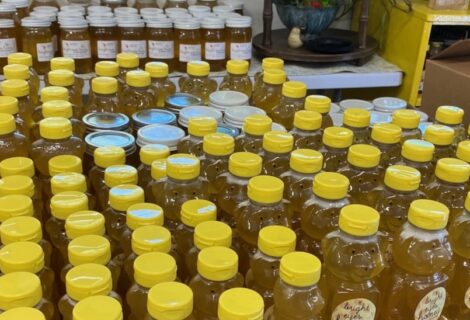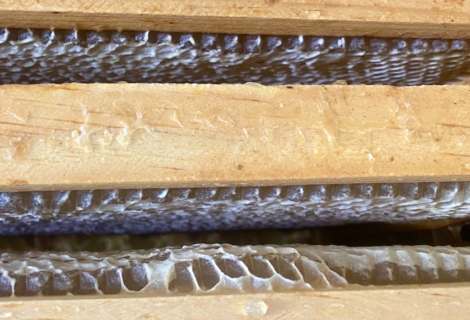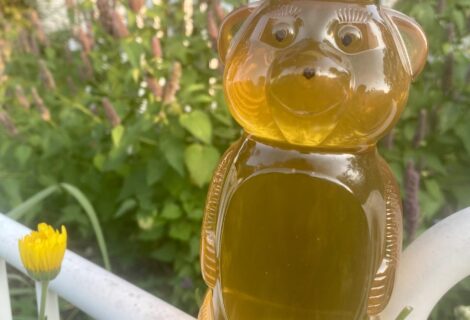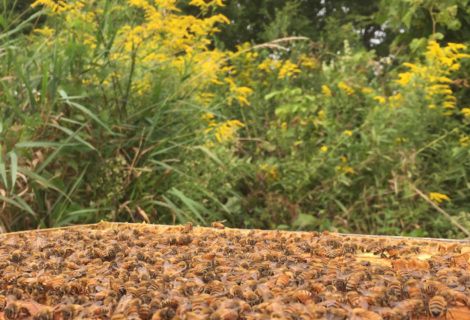Wow, a dozen queenright hives!
By the time I got to the bee-yard, we only had a few hours until dark, so had to work fast. My dad helped me arrange things and get setup with a new hive stand and equipment in case I could pull another new colony from the existing splits, and that turned out to be the case.
I checked the first hive (from the triple-split of the prior Sunday), and found eggs right away. So that meant this hive had the queen. I pulled several frames of eggs and brood from the top box and put them in a new medium I had ready to go. I went through every other frame in the colony, but never saw the queen. I hoped I had her in the new box, but wasn’t sure. I left that hive alone for the time being while I worked the other hives. The next one had no eggs, but some frames with queen cells. If the queen cells they were building (with queen larvae in them) looked good, I pulled the whole frame out, including the nurse bees and added it to the new box I was building up. And I replaced the frames I took with empties – same in the first hive that I dealt with. Any other queen cells I found, I scraped off. Then I wedged in one of the queen cages between two frames of brood, and closed up the hive.
I did the same thing with the 3rd hive of the original split. I removed several frames with bees and queen cells and put them in a new medium box. Other queen cells I destroyed. The tricky part is getting all the queen cells. It had only been 5 days since the split, so the new queen cells needn’t be that large, but I was still banking on the fact that they would be building them in a downward orientation, and not a horizontal cell that would look like an uncapped drone cell. And there were a lot of drone brood cells in these colonies. If I would have been able to introduce the new queens at the same time I made the split, then this activity of fining the queen cells would not have been necessary since the bees would not have started building them yet. But there’s another school of thought that says you should leave a colony queenless for 24 hours (0r some period of time) before introducing a queen. This tends to make the colony more anxious/receptive to accepting of the new queen. But I talked to an Amish beekeeper last Monday and he said the trouble is that the bees start building new queens within hours of going queenless. It doesn’t take long for a smaller colony to realize that it is without a queen. This gentlemen had been waiting 36 hours after a split to introduce a new queen cage into the colony, and ended up having acceptance trouble or swarming trouble. This is because the bees can decide to keep building their queen cells. If they do that, then your hive is getting setup for a showdown. Either they don’t accept the queen you introduced (this means that they “ball her” – and she’s killed – after eating through the candy plug and releasing her), or the newly hatched virgin queen kills the one you introduced, or the one you introduced treats the situation as colony reproduction, takes off with a swarm before the virgin queens hatch.
So I think it is best to either introduce the new queen within a matter of hours after the split, or do what I did here and wait a number of days so that the queen cells they are building are more “obvious” and you can get rid of them, or better yet, use them to start a new colony. The candy plug in the queen cages is designed as a four-day release mechanism, so that should be plenty of time for the colony to adapt to the new queen’s pheromones and be accepting of her (I hope).
Anyway, I also inspected the other two over-wintered colonies again. I knew that 15-D was very likely queenless based on the queen cells with larvae I had seen the prior Sunday. And that turned out to be the case. I was afraid that a virgin queen may already have hatched from one of their cells, but that did not look to be the case. There was still an uncapped queen larva and the other cells still seemed to be intact. I think I took a frame of these and also added it to my box for the new colony I was building. And I introduced a queen cage to this colony as well. The other colony, 15-E, was pretty week, but I saw the queen and there was a good amount of brood in the nest. So I left it alone. I saw evidence of what looked like deformed wing virus (DWV) in the colony, but I’m not sure. Maybe I was just looking at bees that happened to wear out their wings on their last flight, but still made it back to the hive. I’m going to have to keep monitoring it and then decide what to do.
After this, I went through the first box of frames again that I had removed from the colony that had the old queen, hoping I would spot her, and I did, fortunately. (We were using flashlights at this point, to check for eggs and the queen. Fortunately there was no wind, otherwise this would not have been a pleasant exercise). So that meant I could safely re-queen the colony I had taken her from, and I did that. My dad commented on how small she looked, and that didn’t surprise me since she obviously wasn’t laying with the vigor she had been earlier in March and April. We added empty frames to fill out the two boxes containing the old queen and the queen cells taken from the various other colonies, and then we put the two boxes on a new hive stand, and we had a 4th double-brood box colony coming from a single overwintered hive before May. In my mind, that’s pretty impressive for this region.
Now I need to decide whether to leave the old queen in the new colony, or remove her before the virgin queens hatch. If she could still last the season, I have half a mind to pull a fresh nuc with her in it and month down the road if the new colony does not successfully raise and mate a new queen, I could always re-introduce her back into it. But leaving it the way it is, is actually more interesting and may not waste the queen. The reason is that for a lot of the bees in the colony, that is their queen. And for the rest, that was their queen until a week ago, but now they are building a new one. If enough of the bees protect the old queen, they may prevent the virgin queen from stinging her. If they can do that until the virgin queen takes her mating flight(s), then the new queen will return and they can both work the hive. If that hive had two queens working, it could turn out fairly strong. Some people are surprised at the notion of a multi-queen colony. But you have to understand that it’s mainly the virgin queens that sting their rivals. A laying queen is bulked up and has difficulty curving her abdomon in a configuration that allows her to sting. So, if you can somehow get two laying queens together, they may tolerate each other, especially in a larger hive where they can work far enough apart and their pheromones still function for binding and cohering a subset of the bees. This last part is more of a guess though.
Anyway, right now, we have twelve total colonies, and each of them has a queen. I know that state may not last very long, and I’ve read some literature that suggests the success rate of introducing a new queen into a queenless colony really goes down the more days that pass after it was split/gone queenless. But I’m hoping that is because the in-progress queen cells were not eliminated. Anyway, since I got marked queens, I’ll be able to tell whether the marked one still survives or not. I plan to check on Tuesday – basically the 4 day mark after putting in the queen cages. If any colony has already killed their marked queen, I should be able to graft in a queen cell from the ones I saved in the new split I made Friday. If a colony has not yet released their marked queen, I’ll check to see if it looks like they are accepting of her (feeding her, not acting aggressive), and then I’ll release her myself. And if there’s still a queen in the newest split, I’ll try to mark her myself, so that I can better track what happens to that colony.







Recent Comments